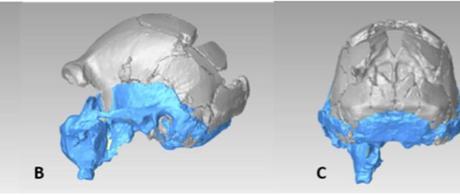
Homo naledi is a recently discovered member of our family. Which makes it special. But what makes it more special is that it is a "mosaic" of ape-like and human-like characteristics. This has gotten creationists very confused since - according to them - this sort of "transitional" form between the two groups shouldn't exist.
A prime example of the confused creationist is the Institute for Creation Research. This multi-million dollar "educational" & "research" organisation can't decide whether Homo naledi is an ape or a human. If they can neatly lump it into one of those categories then it can be stripped of its "transitional" label.
So first they went with the "it's just a human angle":
Their human feet and skulls, plus ritualistic burial, show that Homo naledi -if this name stands the test of time-was likely just another human variety.
But added later ammended the article to opt for the "it's just an ape argument" instead
Update: Upon closer examination, the skeletal remains given the name Homo naledi show a host of primate characteristics, and evolutionists have pointed out shortcomings with the ritualistic burial interpretation.
Now they have published yet another post on the subject (and I thought I was milking this discovery) trying to explain how both of their previous claims are true. Yes, Homo naledi is just an ape. And just a human. Definitely not transitional.
Sadly the article isn't just "we have cognitive dissonance". Instead they claim that there are two distinct species being uncovered.
All of these unusual sizes and mixtures of human and ape-like traits indicate that the bones may not even match. Presumed males and females may have come from different species.
This mirrors the thinking of another creationist article, which makes the similar claim
Here's the other problem I have with the conclusions of these papers: it's not clear that the fossils all come from the same species. One of the partial skulls, for example, is noticeably different from the others. It is much more rounded than the others, and it has a much higher forehead than the others. It's hard to understand how that skull can be from the same species as the others.
Last time creationists discussed Homo naledi I predicted that the disagreement over what this fossil is would die down as one narrative rose to prominence. Might the "it's just a bunch of different species" story be the fittest narrative naturally selected by the creationists?
For their sake I hope note because it is painfully untrue. Obviously this is a concern when dealing with lots of fossil fragments. So obviously researchers considered this possibility during their analysis. Whenever bones could be compared they were. With >1500 bones from at least 15 individuals found nearly every bone in the body was found multiple times. That's hundreds of points of comparison between these individuals.
The original paper documenting the discovery reported the results of these hundreds of comparisons:
In all cases where elements are repeated in the sample, they are morphologically homogeneous, with variation consistent with body size and sex differences within a single population.
In other words - with the exception of age, height and sex differences (which are similar to those found in other primates) - all the bones they examined were all basically the same. At least, within the standard amount of variation one expects within a species.
So; months before the creationists concocted their narrative these scientists had already tested it. In fact, they'd tested it hundreds of times. And every single time it was disproven. I wonder if the creationists will realise this before it becomes their dominant narrative.
Am I terrible person if I hope they don't?

